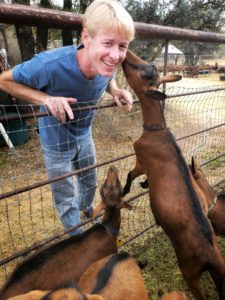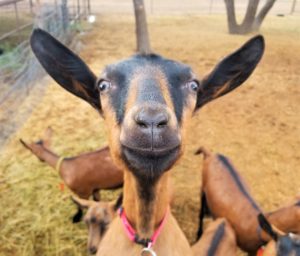
Gary chose the Oberhasli breed because of the flavor and quality of the milk. (Photo courtesy of Capream)
By Lauren Moore, Public Affairs Specialist
Gary Carder is a veteran and owner of Capream Dairy in Prescott, Arizona. This Grade-A goat dairy specializes in the production of milk, gelato, and cheese, which are sold at retail locations around the state.
Ice Cream to Gelato
Originally intending to start an ice cream business, Gary took the Ice Cream Short Course workshop at Penn State University to learn the craft. To source the milk for his ice cream, Gary purchased two Oberhasli goats and discovered the naturally low-fat content from the milk made better gelato.
“Goat ice cream is good, but goat gelato is even better,” he said. “I chose this particular breed because of the flavor and quality of the milk. Our milk is on the sweet side, so all of our products have a sweet flavor.”
Gary later added 14 females and two males to expand his herd. Capream is now home to over 200 goats.
“Oberhasli goats produce slightly less per goat compared to other breeds and that’s why we needed to grow a larger herd,” said Gary. “Our breeding program is increasing production capacity.”
Working with USDA
Operating loans from USDA’s Farm Service Agency helped Capream with operating costs of the dairy, particularly with purchasing equipment. These loans are a valuable resource for agricultural producers to start, maintain, and strengthen a farm or ranch.
“The support I’ve gotten from USDA has been a huge part of my enjoyment in this whole experience,” said Gary. “It’s helped grow a small upstart from nothing.”
A priority of Capream is staying informed about USDA programs and services that can further expand the business.
“We are continually monitoring and learning as much as we can about the various programs and services USDA offers,” said Greg O’Reilly, CEO of Capream. “Given our current stage of growth, the USDA is going to continue to be our best friend.”

Operating loans helped Capream with operating costs of the dairy. (Photo courtesy of Capream)
Education and Engagement
Capream currently sells whole milk, chocolate milk, and cheese, and is ramping-up production for several flavors of gelato and a goat milk gelato sandwich. These products can be found in select grocery stores in Arizona, including AJ’s Fine Foods, Natural Grocers and Whole Foods Market.
From the goats to consumers, Capream is involved in the creation of these products every step of the way. Capream does in-store demonstrations to market their products and educate consumers on the benefits of goat dairy products. This has proven essential to their growth.
“Because of these demonstrations, we have gotten to know some of our customers and their families,” said Greg. “When we have some time in our daily schedules, we like to stop by the stores, set up shop, and share milk with people.”
Leaving a Legacy
Community involvement is important to Capream. The company is currently exploring opportunities to partner with the school system to give students hands-on experience with the goat industry.
“I want to leave something behind for our community,” said Gary.
With goals to expand the company over the next few years, Capream hopes to grow its employee base by creating job opportunities for people in the area and stimulate economic development.
“Gary has a great vision for this company,” said Greg. “Along with growing a successful dairy, we want to leave a legacy and be a good employer.”
More Information
USDA offers a variety of risk management, disaster assistance, loan, and conservation programs to help agricultural producers in the United States weather ups and downs in the market and recover from natural disasters as well as invest in improvements to their operations. Learn about additional programs.
For more information about USDA programs and services, contact your local USDA service center.
JOIN THE CONVERSATION
For the digital version of this blog, visit #FridaysOnTheFarm.
Follow the #FridaysOnTheFarm story series and other news you can use on farmers.gov and our social media channels: Twitter, Instagram, YouTube, Flickr, and Facebook.





